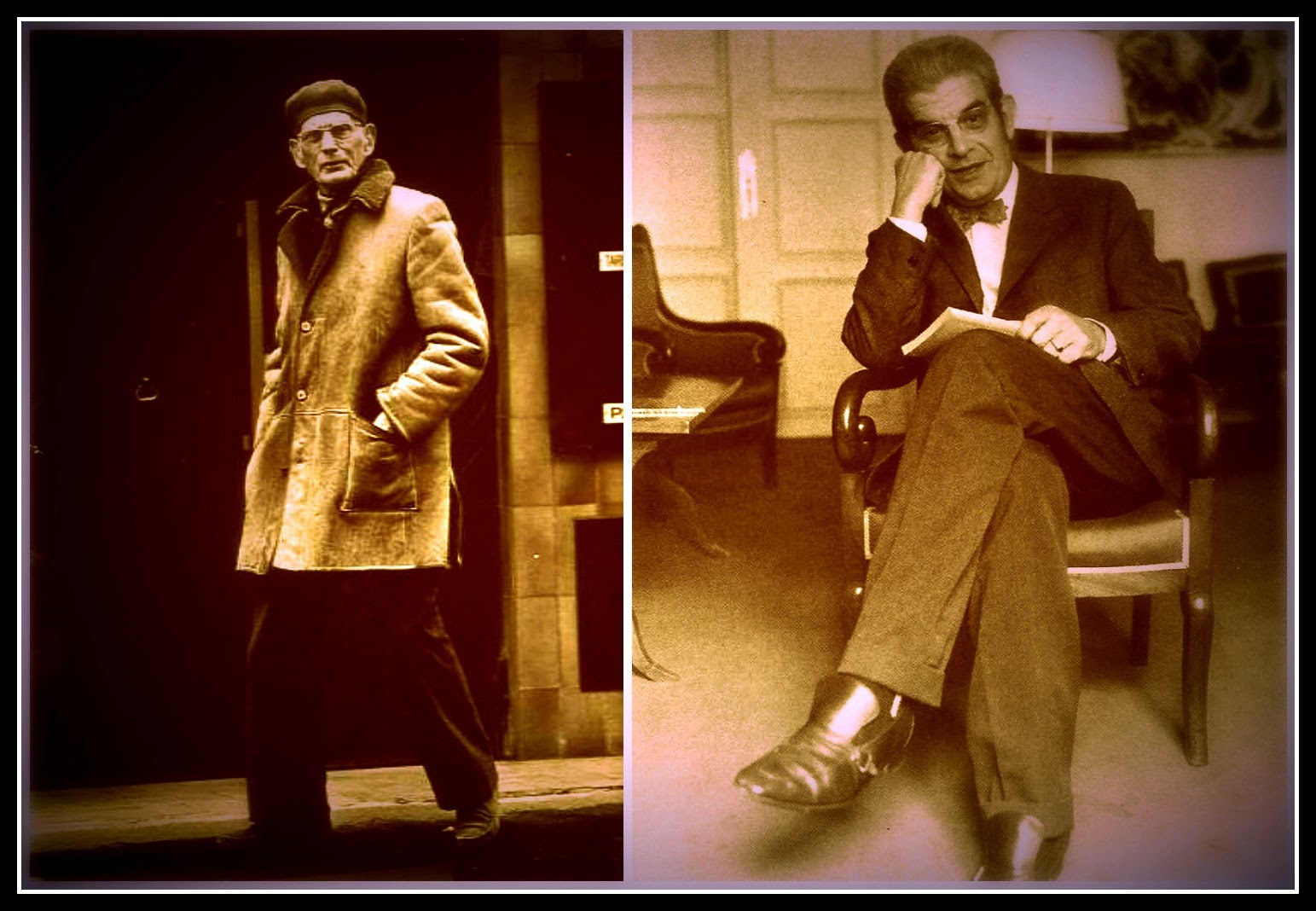২০১৪র ১৩ই এপ্রিল এলো। স্যাম বেকেটের ১০৮ নম্বর জন্মদিন। জাক লাকার ১১৩তম।
আমার সাথে বেকেটবাবুর বসত গড়া, সংসারানোর ১০ বছর দেখতে দেখতে কেটে গেল। বাবার বইয়ের তাকে গোডো নাম দিয়ে শুরু হওয়া ঔৎসুক্য, তখন আমি ইস্কুলে পড়ি। কিছুই বুঝিনি কিন্তু বাবা গল্পটা বলেছিল: মুক্তপ্রান্তরে দুজন মানুষের অনন্ত অপেক্ষার রূপকথা যেন।
তারপর কলেজ। সৌরিৎ ভট্টাচার্যের প্ররোচনায় বেকেট ফেরৎ এলেন। এবং মুশায়েরার বেকেট সংখ্যায় বাবা বেকেটের শেষ ট্রিলজি নিয়ে যে লেখাটা খানিক অভিভূত হয়েই লিখে উঠতে পারেনি সেই অলিখিত না পারা থেকে প্রেসিডেন্সী কলেজের ম্যাগাজিনে আমার লিখিত না পারা: বেকেটের Worstward Ho নিয়ে একটি আলোচনা। ততদিনে ২০০৫।
তারপর ২০০৬, জন্মশতবর্ষ। কলকাতার রাস্তায় কত হন্যে হয়ে ঘুরে বেরিয়েছি বেকেটের বই বিশেষত উপন্যাস ও গদ্যাবলির খোঁজে। তখন ছিল না আমাজনের ক্রেডিট কার্ড কিম্বা ফ্লিপকার্টের সুরম্য কার্ট। তাই কলকাতায় বসে বেকেটবাজি ছিল দুরূহ এক স্ট্রাগল। তবে সেইসব হয়রানিও এখন ফিরে তাকালে মূল্যবান মাল্যবান মনে হয়। এক পরিচিতার সাহায্যে এসে পড়ল গ্রোভ সেন্টিনারী ভলিউম। আরো খানিক এগোনোর হাতছানি।
তারপর একে একে বছর ঘুরেছে। মনে আছে একদিন বন্ধুদের যৌবনের আবিলতায় উন্মত্ত হয়ে বলতাম কোথাও কেউ না নিলেও কোই বাত নেহি : সাদা খাতা আর কালো কালি থাকলে বেকেট নিয়ে কাজ করা কে আটকাবে? ত্বিষার হয়ত মনে থাকবে সেকথা। তারপর নবেন্দুর সাথে লেখালিখির মাধ্যমে বেকেটযাপন। বেকেটের জন্যেই কত বন্ধু হয়েছে।
আমার বান্ধবী এবং বর্তমানে আমার স্ত্রী অনুপর্ণার সাথে অনুভূতিমালাও তো কখনো বেকেট থেকে দূরে থাকেনি। আমাদের প্রথম বা প্রাক-প্রথম প্রেমপত্রগুলো ছিল ওর পাঠানো বেকেটের ওপর নানা বইয়ের জেরক্স এবং তার সাথে মোড়া চিঠি আর আমি উত্তর দিয়েছি যন্ত্রচিঠিতে। এভাবেই শুরু হয়েছে সবকিছু। বেকেটের আশেপাশে।
যাদবপুরে পড়াকালীন শান্তনু বিশ্বাসের কল্যাণে জাক লাকা চর্চা শুরু। এবং শান্তনুদার মুগ্ধতায় লাকা বিগত ৫ বছরে অনেকটা কাছে। এখন আমার গবেষনার বিষয় বেকেট ও লাকা। ১০ বছরে হওয়া ২ টি প্রেমের সমন্বয় যেখানে আসলে আমি নিজেকেই পড়ছি,পড়ছি নিজের ফ্যান্টাসিকে তাঁদের ভিতর দিয়ে। আর মজার ব্যপার হলো এই দুটি মানুষের জন্মদিনটাও এক। যেন তাদের মধ্যেকার অদৃশ্য কোনো প্রেমপর্ব, অদেখা একটা আম্বিলিকাল কর্ড।
২ মাস হলো মা চলে গ্যাছে। এখন পড়ার টেবিলে বেকেট বাবুর পাশে মার সহাস্য ছবি। যেন দুজনে কত গল্প করছে, হয়ত আমার নামে নালিশ চলছে। মা হয়ত বলছে, 'এই যে দাদা আপনিই ছেলের মাথাটা খেলেন দেখলাম'। আমি ওখানে গেলে কেউই আর ছেড়ে কথা বলবে না।
বেকেট বাবুকে কখনো কখনো খুব নালিশ করেছি আমার জীবনকে ওনার লেখার বিষয়ে পরিণত করছেন বলে মনে হওয়ায়। পূর্বনির্ধারিত বিবাহের কয়েকদিন আগে মার সহসা চলে যাওয়ায় বেকেটীয় ভঙ্গিতে 'ফার্স্ট লাভ' এর নায়কের প্রথম বাক্যে বাবার জায়গায় মা শব্দটা বসিয়ে আমাকে আজীবন বলে যেতে হবে: " I associate, rightly or wrongly, my marriage with the death of my mother, in time".
এইসব উত্থান পতন নিয়েই আমার আর বেকেটবাবুর সংসারের এক্কা দোক্কা। জাক লাকা সেখানে আমাদের ট্রান্সফারেন্স দেখে মজা পান নিশ্চই। আমি বেকেট আর লাকা দিয়ে হয়ত তৈরী হয় আমার কাজকর্মের বরমিয়ান নট।
আজ আমার দুই গুরুর জন্মদিনে এই সংক্ষিপ্ত ইতিহাসটাই বলতে ইচ্ছে করলো।
আমার সাথে বেকেটবাবুর বসত গড়া, সংসারানোর ১০ বছর দেখতে দেখতে কেটে গেল। বাবার বইয়ের তাকে গোডো নাম দিয়ে শুরু হওয়া ঔৎসুক্য, তখন আমি ইস্কুলে পড়ি। কিছুই বুঝিনি কিন্তু বাবা গল্পটা বলেছিল: মুক্তপ্রান্তরে দুজন মানুষের অনন্ত অপেক্ষার রূপকথা যেন।
তারপর কলেজ। সৌরিৎ ভট্টাচার্যের প্ররোচনায় বেকেট ফেরৎ এলেন। এবং মুশায়েরার বেকেট সংখ্যায় বাবা বেকেটের শেষ ট্রিলজি নিয়ে যে লেখাটা খানিক অভিভূত হয়েই লিখে উঠতে পারেনি সেই অলিখিত না পারা থেকে প্রেসিডেন্সী কলেজের ম্যাগাজিনে আমার লিখিত না পারা: বেকেটের Worstward Ho নিয়ে একটি আলোচনা। ততদিনে ২০০৫।
তারপর ২০০৬, জন্মশতবর্ষ। কলকাতার রাস্তায় কত হন্যে হয়ে ঘুরে বেরিয়েছি বেকেটের বই বিশেষত উপন্যাস ও গদ্যাবলির খোঁজে। তখন ছিল না আমাজনের ক্রেডিট কার্ড কিম্বা ফ্লিপকার্টের সুরম্য কার্ট। তাই কলকাতায় বসে বেকেটবাজি ছিল দুরূহ এক স্ট্রাগল। তবে সেইসব হয়রানিও এখন ফিরে তাকালে মূল্যবান মাল্যবান মনে হয়। এক পরিচিতার সাহায্যে এসে পড়ল গ্রোভ সেন্টিনারী ভলিউম। আরো খানিক এগোনোর হাতছানি।
তারপর একে একে বছর ঘুরেছে। মনে আছে একদিন বন্ধুদের যৌবনের আবিলতায় উন্মত্ত হয়ে বলতাম কোথাও কেউ না নিলেও কোই বাত নেহি : সাদা খাতা আর কালো কালি থাকলে বেকেট নিয়ে কাজ করা কে আটকাবে? ত্বিষার হয়ত মনে থাকবে সেকথা। তারপর নবেন্দুর সাথে লেখালিখির মাধ্যমে বেকেটযাপন। বেকেটের জন্যেই কত বন্ধু হয়েছে।
আমার বান্ধবী এবং বর্তমানে আমার স্ত্রী অনুপর্ণার সাথে অনুভূতিমালাও তো কখনো বেকেট থেকে দূরে থাকেনি। আমাদের প্রথম বা প্রাক-প্রথম প্রেমপত্রগুলো ছিল ওর পাঠানো বেকেটের ওপর নানা বইয়ের জেরক্স এবং তার সাথে মোড়া চিঠি আর আমি উত্তর দিয়েছি যন্ত্রচিঠিতে। এভাবেই শুরু হয়েছে সবকিছু। বেকেটের আশেপাশে।
যাদবপুরে পড়াকালীন শান্তনু বিশ্বাসের কল্যাণে জাক লাকা চর্চা শুরু। এবং শান্তনুদার মুগ্ধতায় লাকা বিগত ৫ বছরে অনেকটা কাছে। এখন আমার গবেষনার বিষয় বেকেট ও লাকা। ১০ বছরে হওয়া ২ টি প্রেমের সমন্বয় যেখানে আসলে আমি নিজেকেই পড়ছি,পড়ছি নিজের ফ্যান্টাসিকে তাঁদের ভিতর দিয়ে। আর মজার ব্যপার হলো এই দুটি মানুষের জন্মদিনটাও এক। যেন তাদের মধ্যেকার অদৃশ্য কোনো প্রেমপর্ব, অদেখা একটা আম্বিলিকাল কর্ড।
২ মাস হলো মা চলে গ্যাছে। এখন পড়ার টেবিলে বেকেট বাবুর পাশে মার সহাস্য ছবি। যেন দুজনে কত গল্প করছে, হয়ত আমার নামে নালিশ চলছে। মা হয়ত বলছে, 'এই যে দাদা আপনিই ছেলের মাথাটা খেলেন দেখলাম'। আমি ওখানে গেলে কেউই আর ছেড়ে কথা বলবে না।
বেকেট বাবুকে কখনো কখনো খুব নালিশ করেছি আমার জীবনকে ওনার লেখার বিষয়ে পরিণত করছেন বলে মনে হওয়ায়। পূর্বনির্ধারিত বিবাহের কয়েকদিন আগে মার সহসা চলে যাওয়ায় বেকেটীয় ভঙ্গিতে 'ফার্স্ট লাভ' এর নায়কের প্রথম বাক্যে বাবার জায়গায় মা শব্দটা বসিয়ে আমাকে আজীবন বলে যেতে হবে: " I associate, rightly or wrongly, my marriage with the death of my mother, in time".
এইসব উত্থান পতন নিয়েই আমার আর বেকেটবাবুর সংসারের এক্কা দোক্কা। জাক লাকা সেখানে আমাদের ট্রান্সফারেন্স দেখে মজা পান নিশ্চই। আমি বেকেট আর লাকা দিয়ে হয়ত তৈরী হয় আমার কাজকর্মের বরমিয়ান নট।
আজ আমার দুই গুরুর জন্মদিনে এই সংক্ষিপ্ত ইতিহাসটাই বলতে ইচ্ছে করলো।






